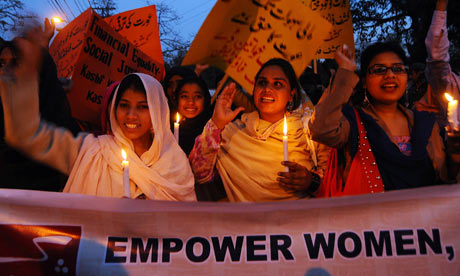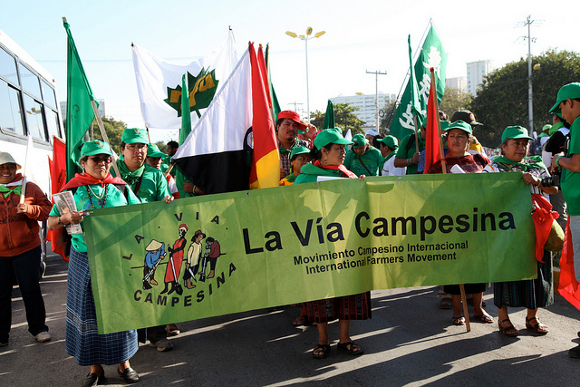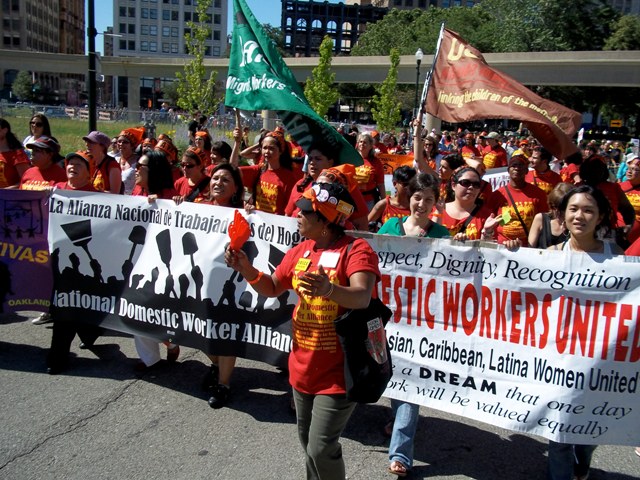by Johanna Brenner
March 8, 2014
This article is an edited version from “Twenty-first Century Socialist Feminism,” Socialist Studies, (Spring 2014). It appears in the March/April 2014 issue of Against the Current.

Pakistani women celebrate International Women’s Day.
In the 21st century, women of the working classes — employed in the formal economy, the informal economy, working in the countryside or doing unwaged labor — have entered the global political stage in an astonishing array of movements. Sparked by the capitalist war on the working class, the enclosures sweeping peasants and farmers off the land or devastating their livelihoods upon it, and the consequent crisis and intensification in patriarchal relations, these movements are creatively developing socialist-feminist politics — with much to offer the left as it gropes toward new organizational forms and organizing strategies.
In the global south, as women find themselves displaced, employed in precarious work, heading households, struggling to survive in informal settlements and urban slums, they are not only crucial participants in movements for 21st century socialism, they are also building grassroots organizing projects that challenge patriarchal forms of organizing, leadership, and movement demands.
In the global north, these projects have engaged new modes of worker organizing that rely on mobilizing members and building community alliances. While never perfect, of course, these different socialist-feminist projects, in north and south, in community and workplace, at their best offer new discourses of gender equality, new modes of organizing, and visions of participatory democracy.
The 21st century has also seen an expansion and deepening of transnational feminist networks. There are, of course, class tensions within these networks and some networks deal with these tensions better than others.1 Still, the networks are crucial resources for socialist-feminist organizing, for it is through them that feminist discourses circulate globally, are incorporated locally and often creatively re-shaped in the process.2
We can think of socialist feminism very broadly — to include all feminists (whether or not they would identify with the label) who see class as central, but would not reduce relations of power and privilege organized around particular identities (gender, sexuality, race/ethnicity, nationality) to class oppression.
Revolutionary socialist feminism is unwilling to allow capitalism to set the horizon for what can be envisioned or struggled for.
Socialist-feminists start where most feminists begin: the emancipation of women must come from women ourselves, but cannot be achieved by ourselves. From this starting point, socialist-feminists are especially interested in building inclusive movements organized by and for working class, indigenous, and rural women.
Women’s self-organization can be parochial or coalitional — that is, it can either reproduce existing social divisions among women or reach beyond them. The political vision through which socialist-feminists organize aims to develop activism and leadership, education and awareness, demands and discourses, and an everyday politics that recognizes and works to overcome these deep divisions. In this process socialist feminists look to developing a “both/and” politics that bridges what might be won in the here and now to a longer-term project of social transformation.
The Global South
I think we all recognize that a democratic spirit is in the air — exemplified in Occupy, Tahrir square and the Indignados. These movements echoed the popular assemblies and other democratic experiments such as participatory budgeting that have been so central to building “21st century socialism.”

Women in Tahrir Square.
Beyond these moments of upsurge, women of the working classes have been carrying forward grassroots projects that incorporate and draw from the participatory democratic ethos that will be central to reconfiguring the left. Easily shut out of formal, hierarchical, bureaucratic organizations, they are central to local movements and have the most to gain from new forms of citizenship that encourage and support political participation from the ground up.3
Their organizing projects aim to build alternatives to “masculinist” and hierarchical styles of work that are barriers to women’s self-development and leadership. They are also intent on organizing in communities and workplaces to win reforms, including reforms in law and government policies. Thus, activists are forced to think through how to meld the “horizontalism” inspired by the Zapatistas and other autonomous left currents with activist engagement with the state.
I offer two examples, the Coalition for Justice in the Maquiladoras (CJM) and Via Campesina, to illustrate different aspects of socialist-feminist strategies and their potential contribution to organizing anti-capitalist struggles.4
Formed in 1989 during the NAFTA debates, CJM is a multi-sectoral, international coalition that supports Mexican factory workers. CJM’s coordinator, Martha Ojeda, began as a maquiladora worker, became an organizer, and eventually helped to found CJM.
CJM teaches workers to do their own research on the companies, mapping the process of production, identifying the costs of inputs compared to the prices of the products sold, identifying health and safety conditions that violate international labor law. Working together builds trust and cohesion. Additionally, by developing workers’ knowledge and analytic skills, CJM undermines the mystique of expertise that is so crucial to managerial authority and encourages confidence in a democratic socialist vision of society.
One of CJM’s areas of organizing on northern Mexico’s border is Nuevo Laredo, Tamaulipas, a hub for maquiladoras. Between 2001 and 2007, CJM organized several meetings that brought together maquiladora workers, campesinos and indigenous community members from Chiapas.5
In addition to creating a space for thinking critically about gender relations, these meetings bridged historic racial divisions between the indigenous people from Mexico’s south and maquiladora workers in the north. They enabled communities to learn from each other’s long history of organizing.
In 2004, workers and their families sought to settle on formerly ejido (communal) land where they could live without paying rent and grow some of their own food. After invading the land, residents were evicted by order of the mayor of Nuevo Laredo; but they returned again in 2005. Women took the lead both times.
Originally the colonia residents organized for recognition and services from the city government, but after enduring several years of the government’s violence and neglect, and following several exchanges with activists from the Zapatista communities in Chiapas, they decided to channel their energies into sustaining themselves.
Women continue to play leadership roles there and residents are pursuing sustainable economic projects such as taking over a nearby water source and installing faucets on several streets. They have built a small clinic, solar ovens and a wind generator, and established community gardens of fruit trees, vegetables, and medicinal herbs.
CJM provides childcare for all their meetings and functions and encourages the small but significant “gender adjustments” that emerge in women’s lives when they become politically active.6 CJM’s Worker Empowerment Program provides an opportunity for women to develop analyses of gender relations in their homes, organizations and communities.
According to Ojeda, “The women organizers involved in the CJM Empowerment Program make connections among all forms of violence. They learn that the root of the problem is not just a patriarchal system but also a capitalist system that behind the scenes generates violence against women, including the latest violence perpetrated by organized crime, which is also a consequence of the neoliberal capitalist regime.
“Women of the colonia Blanca Navidad in Nuevo Laredo, women from the maquilas, indigenous women and campesinas from Chiapas who have been involved in the encuentros relate violence to the lack of land rights, lack of access to decent housing and jobs, to health care, and education.”7
Via Campesina’s Example
Violence Against Women has also been taken up by rural women organizers in La Via Campesina, an international coalition of peasants, farmers, farm workers and indigenous agrarian communities from a wide diversity of locations and cultures. Women activists in Via have been organizing to reshape gender relations within their organizations and in their communities.
At its founding, in 1992, Via reflected the patriarchal norms and political outlook of its member organizations — for example, all of the regional coordinators elected at the first international conference were men. The formation of a Women’s Commission in 1996 created the space for women within Via Campesina to organize and challenge patriarchal practices and policies.

Although special organizational bodies for dealing with women’s issues can be instruments for cooptation and marginalization, this has not been the case in Via Campesina. Annette Desmarais argues that this is partly because of the (relatively) democratic functioning of the Via.8
The Women’s Commission, and the separate international conferences for women activists it organized, have had a significant impact on the representation of women in Via and in its member organizations.
In October 2008, La Via Campesina’s 3rd International Assembly of Women approved the launch of a campaign targeting all forms of violence faced by women in society (interpersonal as well as structural). In linking state violence directed at their communities to violence against women perpetrated in their communities, the women of Via Campesina followed a path taken by indigenous women and women of color organizing against gender violence in North America.
Mainstream feminist anti-violence organizations have essentially dropped any critique of the repressive arm of the state, and regard discussion of the link between men’s violence and conditions of oppression and exploitation as “letting men off the hook.” However, women of color organizations have insisted that gender violence in their communities cannot be dealt with in separation from the violation of their communities.9
Sacred Circle, a South Dakota-based American Indian resource center for domestic and sexual violence, argues that Indigenous sovereignty cannot be achieved without the well-being of Native Women.10 From their particular social location, Indigenous women activists are here developing a politics that rejects the counter-position of collective to individual rights by demonstrating that winning collective rights (sovereignty), and building a community based on those rights, both depend on the full participation and equality of women (recognition of their individual bodily rights) within a community of struggle.11
In June 2013, following the lead taken by the Women’s Assembly, held just prior to their 6th International Conference, Via Campesina voted to include, for the first time, opposition to homophobia as part of the organization’s program of work. The Call voted on by the VI Conference of La Via Campesina states:
We demand respect for all women’ rights. In rejecting capitalism, patriarchy, zenophobia, homophobia and discrimination based on race and ethnicity, we reaffirm our commitment to the total equality of women and men. This demands the end to all forms of violence against women, domestic, social and institutional in both rural and urban areas. Our Campaign against Violence towards Women is at the heart of our struggles.12
This is especially interesting because sexual self-determination and abortion rights have often been “off the table” in movements engaging women of the working classes, and more generally there have been significant tensions (which map onto differences of race/nationality/ethnicity and class) between activists organizing around women’s practical gender interests (based in women’s caring roles in family and community) and activists organizing around demands that emerge from women’s strategic gender interests (based in women’s search for bodily and sexual self-determination).13
In the 21st century, socialist-feminist ideas have gained much greater purchase as women in popular movements, whether urban or rural, have self-organized to challenge patriarchal norms. It seems that in the Via Campesina, the tension between practical gender interests and strategic gender interests has been overcome, at least in part, through the organization of women within Via and their productive collaboration with the World March of Women and other socialist-feminist transnational organizations.
Via’s recognition of homophobia reflects the global mainstreaming of LGBT rights which has proceeded with an almost unprecedented rapidity over the last few years. Yet it is important to note that, in contrast to the liberal politics of marriage rights now sweeping the United States, in Via Campesina the struggle against homophobia is inserted into an inclusive collective vision of transformation that is also anti-racist and anti-capitalist.
The Global North
Turning now to the global north, I want to bring into focus the politics of caring labor and how a socialist-feminist perspective might contribute to organizing against austerity. Although the strength and reach of public services varies widely across countries, everywhere the trend is toward the privatization and informalizing of caring for young children, the elderly, the disabled and the ill.
This is the prominent face of neoliberal structural adjustment in the global north. It has created a demand for immigrant labor, shifting the gender of migrants from predominantly male to predominantly female.14
Women workers in the care sector span a wide range in terms of class — from trained early education teachers and managers of day care centers to the childcare workers, teachers’ aides, house cleaners, nannies, home care workers, nursing home attendants, and others whose skills are unrecognized and low-paid. Citizenship status and racial/ethnic identity are mapped onto these differences as well.
If we expand our view of caring labor to include hospitals and public schools, we see that women workers and their unions are increasingly under the sign of the “welfare queen” — entitled drains on the budget, and lazy to boot — in other words, barriers to improving public services.
Women trade unionists, especially teachers and nurses, have countered this assault by organizing not only themselves but also the people who depend on their services. As militant teachers have claimed, “our working conditions are our students’ learning conditions.”15 The California Nurses’ Association organized a broad coalition to pass legislation mandating nurse-patient ratios in hospitals.16

Perhaps most unexpected, Domestic Workers United, an organization that began with nannies and housecleaners organizing in New York City, won not only a domestic workers’ “bill of rights” at the city level and then in the New York state legislature, but encouraged the expansion and establishment of other domestic worker organizing projects.
This national movement recently won a ruling from the federal government that, for the first time, domestic workers would be covered by federal laws regulating hours of work, health and safety, overtime pay, and the right to time off.17
Cutting across differences among teachers, nurses and domestic workers, these projects share two central strategies: 1) organizing in and beyond the workplace, and 2) raising awareness of and support for the dignity and importance of caring work. They enact social solidarity, remind us of our interdependence, and defend social responsibility for care. In these ways, they represent a fundamental challenge to neoliberal ideals of entrepreneurship, individualism, and “self-sufficiency.”
One of the most compelling neoliberal political discourses is the demand that government be made “more accountable” by contracting out services to private and nonprofit organizations that are supposedly more flexible and responsive to those who depend on them. We can effectively counter this neoliberal agenda by building on the experiments in democratizing government that have been won through popular and trade union struggles. These creative initiatives offer alternatives to bureaucracy far more compelling than the phony involvement and superficial accountability promised by privatization.
Women are much more present than men as paid care workers and as recipients of caring services (often on behalf of children and adult kin); a movement to democratize care will be a women’s movement. As ever, there will be class tensions and differences especially of race/ethnicity and citizenship to be addressed. Nonetheless, democratizing care is a fruitful avenue for developing socialist-feminist politics and expanding how the left understands the fight against austerity.
Democratizing Care
Attempts to democratize the state through new institutions of participatory democracy have been at the heart of the movement toward 21st century socialism in Latin America. In the global north, experiments to “open-up” government have been much less spectacular but are nonetheless inspiring. They are far from perfect and there is still much to learn.
Still, programs to democratize the state creatively break from the modes of organizing and thinking about government that have dominated union and left strategies, leaving us stuck in a dead-end debate about whether or not to work to reform the state or create autonomous pre-figurative alternatives to the state.18
In Reclaim the State, Hilary Wainwright describes the successes and failures of several attempts to democratize government. One in particular, in Newcastle England, interests me because it’s about a public sector union competing with a private contractor when the local council decided to “outsource” an entire department.
The union proposed a complete reorganization of the department including breaking the bureaucratic hierarchy, engaging workers in every key decision about processes and policies, sharing knowledge and expertise among workers, and providing retraining for individuals whose skills were made redundant. This was not the “teaming” so beloved by corporate managers, but a real democratization through which the department operated more like a worker cooperative than a traditional government bureau. And rather than going around the union, the reorganization brought a level of union involvement at the worksite that previously had not existed.19
Another avenue for organizing to democratize and socialize caring work is the social cooperative. Social cooperatives are workers’ cooperatives recognized and funded by the state and required to include service recipients in their governance. While not in themselves radical, social cooperatives are a field for struggle that challenges neoliberal ideals and opens up a space for socialist-feminist politics.
The neoliberal identification of self-determination with “consumer choice” is both ideological and real. Consumer choice has power because it reflects the actual relationships between institutions that provide public services (whether nonprofits or government programs) and the people who need them. While we can talk abstractly about public goods as those things we own in common, for the most part we experience ourselves in relation to public services as consumers. As users experience them, public goods delivered through bureaucratic, hierarchical, and inaccessible organizations are much closer to commodities than to a commons.
Social cooperatives, combining worker ownership with a mandate to include users of services in decision-making, create social relationships with the potential to constitute publicly funded care services that are more like a “commons” than like consumer goods. On the other hand, they may also be used to facilitate a neoliberal agenda that undercuts public workers and their unions.
A social movement unionism strategy that allies service users and public workers could contend for shared governance of schools, childcare centers, home-care programs and many other institutions at the core of socializing the labor of care.
21st Century Perspectives
Socialist-feminist politics offers a unique perspective for organizing in the 21st century. Socialist-feminists’ commitment to self-organization supports organizational structures that are non-hierarchical and democratic and therefore more inclusive. Attention to intersectionality as a guide to both program and political discourse — the demands that movements make and the language we use to support those demands — opens a ground on which deep social divisions might be overcome rather than reproduced.
Understanding the ways that workplaces, households and communities are interrelated leads to more effective modes of organizing and more possibilities for coalition politics, making connections among what are often seen as very different and separate issues/struggles.
Socialist-feminist visions of leadership and of leadership development promote activists’ capacities for engagement in democratic decision-making and collectivity. The recognition that affect, emotions and sexuality are always present, shaping social relations, encourages activists’ self-reflection, empathy and respect for different ways of being in the world.
In the 21st century, as women of the working classes enter onto the political stage, they are creatively renewing socialist-feminist politics. If we are to build 21st century socialism, then it is time to pay attention to 21st century socialist-feminism, moving its theory and practice from the margins to the center of the revolutionary left.
Johanna Brenner is Professor Emeritus of Sociology and Women’s Studies at Portland State University. She is a member of Solidarity’s National Committee.
Bibliography
Alvarez, Sonia E., 2000, “Translating the Global: Effects of Transnational Organizing on Local Feminist Discourses and Practices in Latin America,” Meridians: feminism, race, transnationalism, vol. 1, no. 1 (Autumn).
Bradbury, Alexandra et. al., 2014, How to Jump-Start Your Union: Lessons from the Chicago Teachers (Detroit: Labor Education and Research Project).
Brenner, Johanna, 1998, “On Gender and Class In US Labor History, ” Monthly Review, vol. 50, n. 6. (November).
Brenner, Johanna, 2000, Women and the Politics of Class (New York: Monthly Review Press).
Brenner, Johanna, 2009, “Democratizing Care,” in Gender Equality: Transforming Family Divisions of Labor eds. Janet C. Gornick and Marcia K. Meyers (New York: Verso).
Brenner Johanna, 2010, “Free Market Feminism,” Monthly Review, Volume 62, Issue 07 (December).
Brenner, Johanna, 2012, “Interview with Martha Ojeda,” (April 4).
Brenner, Johanna and Holmstrom Nancy, 2013, “Socialist-Feminist Strategy Today,” Socialist Register, Volume 49.
Dean, Amy, 2013,”How Domestic Workers Won Their Rights: Five Big Lessons, Yes! Magazine, (October).
Desmarais, Annette Aurélie, 2007, La Via Campesina: Globalization and the Power of Peasants (London: Pluto Press).
Fernandes, Sujatha, 2007, “Barrio Women and Popular Politics in Chavez’s Venezuela, “ Latin American Politics & Society, Vol. 49 Issue 3, (Summer).
Gündüzf, Zuhal Ye?ilyurt, 2013, “The Feminization of Migration,” Monthly Review, Volume 15, no. 7 (December).
Haaken, Janice, 2012, Hard Knocks, Domestic Violence and the Psychology of Storytelling (NY: Routledge).
Hennessy. Rosemary, 2013, Fires on the Border: The Passionate Politics of Organizing on the Mexican Frontera and Elsewhere. (Minneapolis: University of Minnesota Press).
Moghadam, Valentine, 2005, Globalizing Women: Transnational Feminist Networks (Baltimore: Johns Hopkins University Press,).
Molyneux, Maxine, 1985, “Mobilization without Emancipation? Women’s Interests, the State, and Revolution in Nicaragua,” Feminist Studies, Volume 11, No. 2 (Summer).
National Nurses United, “Nurses Answer the Call for Safe Patient Care,” (accessed 12/28/13).
Smith, Andrea, 2007, “Native American Feminism, “ in Making Space for Indigenous Feminisms, ed. Joyce Green (Winnipeg: Fernwood Books).
Via Campesina, 2013 (http://viacampesina.org/en/index.php/our-conferences-mainmenu-28/6-jakarta-2013/resolutions-and-declarations/1428-the-jakarta-call).
Wainwright, Hilary, 2009, Reclaim the State: Experiments in Popular Democracy (London: Seagull Books).
Footnotes
1 Alvarez 2000, Moghadam 2005.
2 Sameh, 2010.
3 See for example, Fernandes, 2007.
4 For these and other examples, Johanna Brenner and Nancy Holmstrom, “Socialist-Feminist Strategy Today,” Socialist Register 2013.
5 Hennessy, 2013.
6 Ibid.
7 Brenner, 2012.
8 Desmarais, 2007.
9 Incite! 2006.
10 Haaken, 2012, 37-40.
11 Smith, 2007.
12 Via Campesina, 2013.
13 Molyneux, 1985.
14 Gündüzf, 2013.
15 Bradbury et. al. 2014.
16 National Nurses United, 2013.
17 Dean, 2013.
18 For a more nuanced discussion than can be presented here, see Brenner 2009.
19 Wainwright, 2009, Chapter 8.
